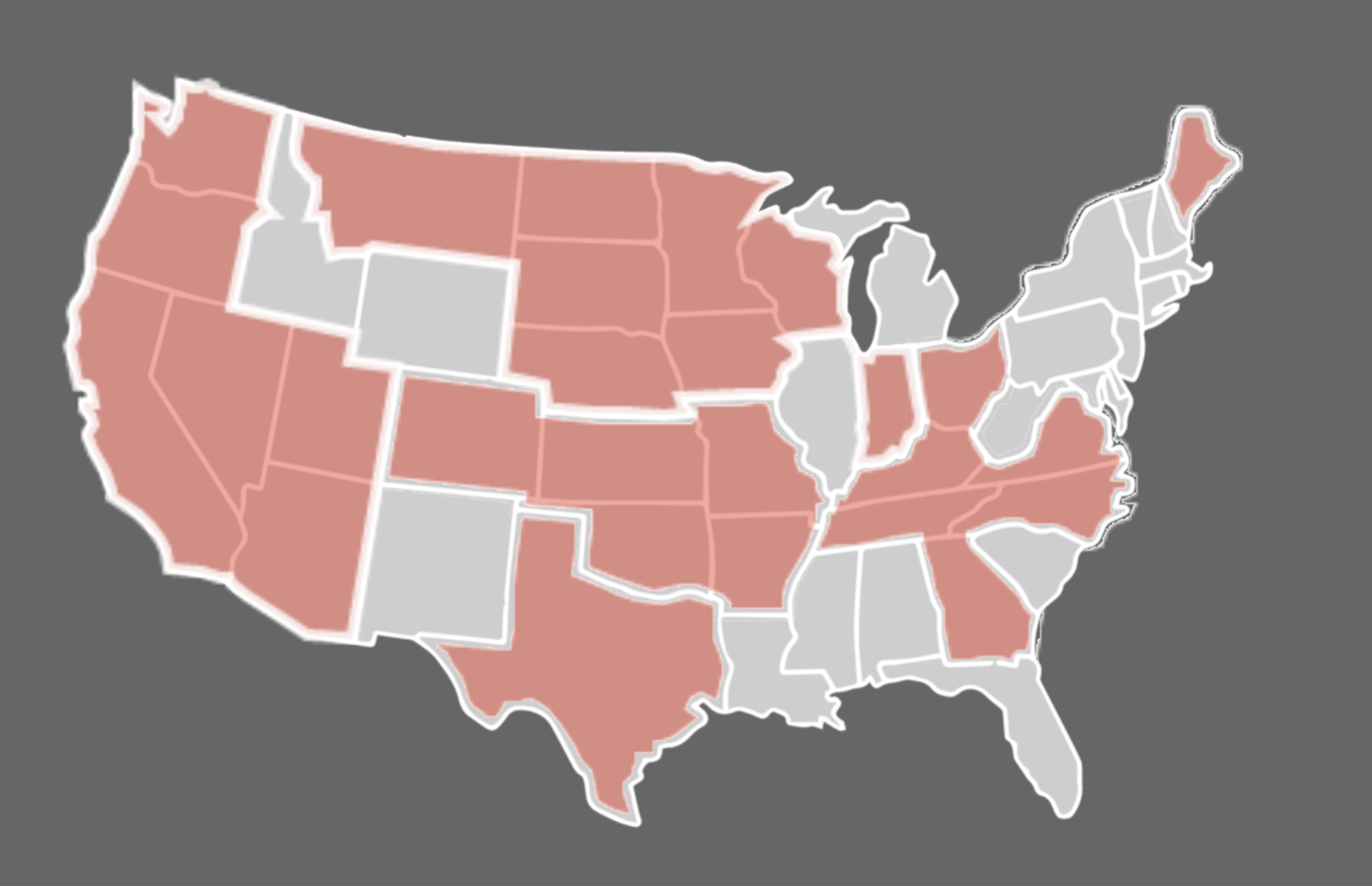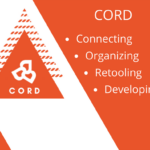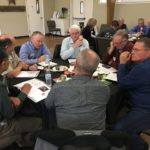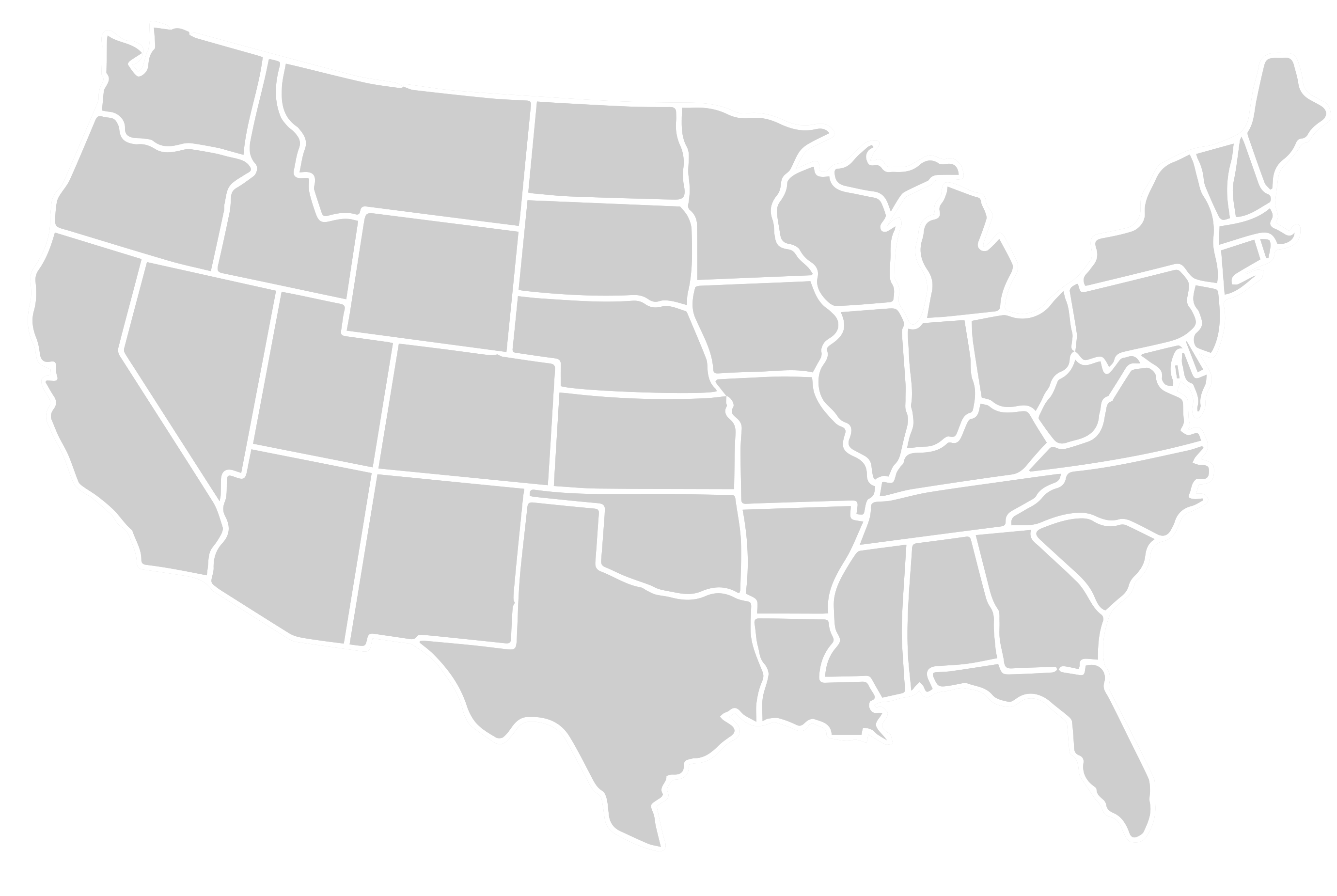- USMB FAMILY
- Who We Are
- Districts & Churches
- District Overview
- CHRISTIAN LEADER
- Title
- How do we live as we wait Christ’s return?I attended a Bible study recently where we looked at Matthew 24 and the end times. Most present subscribed to the pre-tribulation rapture position. I sensed quiet relief in their voices given they believe no Christian will have to endure the great tribulation. But no one commented on the possible times of harsh suffering and persecution American believers could face in the future. No one alluded to the estimated 70 million Christians martyred over the last two millennia, more than half in the 20th century. Todd Nettleton of Voice of the Martyrs describes persecution as “anytime that we’re forced to […]

- Always alert and awakeWar in the Middle East always sparks a renewed interest among Christians regarding what the Bible says about the end times, what theologians call the study of eschatology. In recent generations the formation of the state of Israel, the rising threat of nuclear Armageddon, the collapse of the USSR and other massive geo-political events have spurred interest again and again. And in a way, that’s a good thing. The eagerness to know more may be for the wrong reasons: Who is the antichrist? Is the rapture about to happen? But in Scripture, Jesus calls us again and again to be […]

- A party for Birch BayEach year, more than 10,000 people flock to Birch Bay, Washington, an unincorporated community along the northwest Washington coast, to shoot fireworks on July 4. Birch Bay is one of the only places to shoot fireworks on the beach without a permit, says Birch Bay Bible Community Church lead pastor Tim Thiessen. A county ordinance allows the legal discharging of fireworks July 3-5, and many people buy fireworks on the nearby Lummi Reservation and come to Birch Bay to shoot them off. It’s not uncommon for people to spend $5,000 to $10,000 on fireworks, Thiessen says. “Birch Bay gets overwhelmed […]
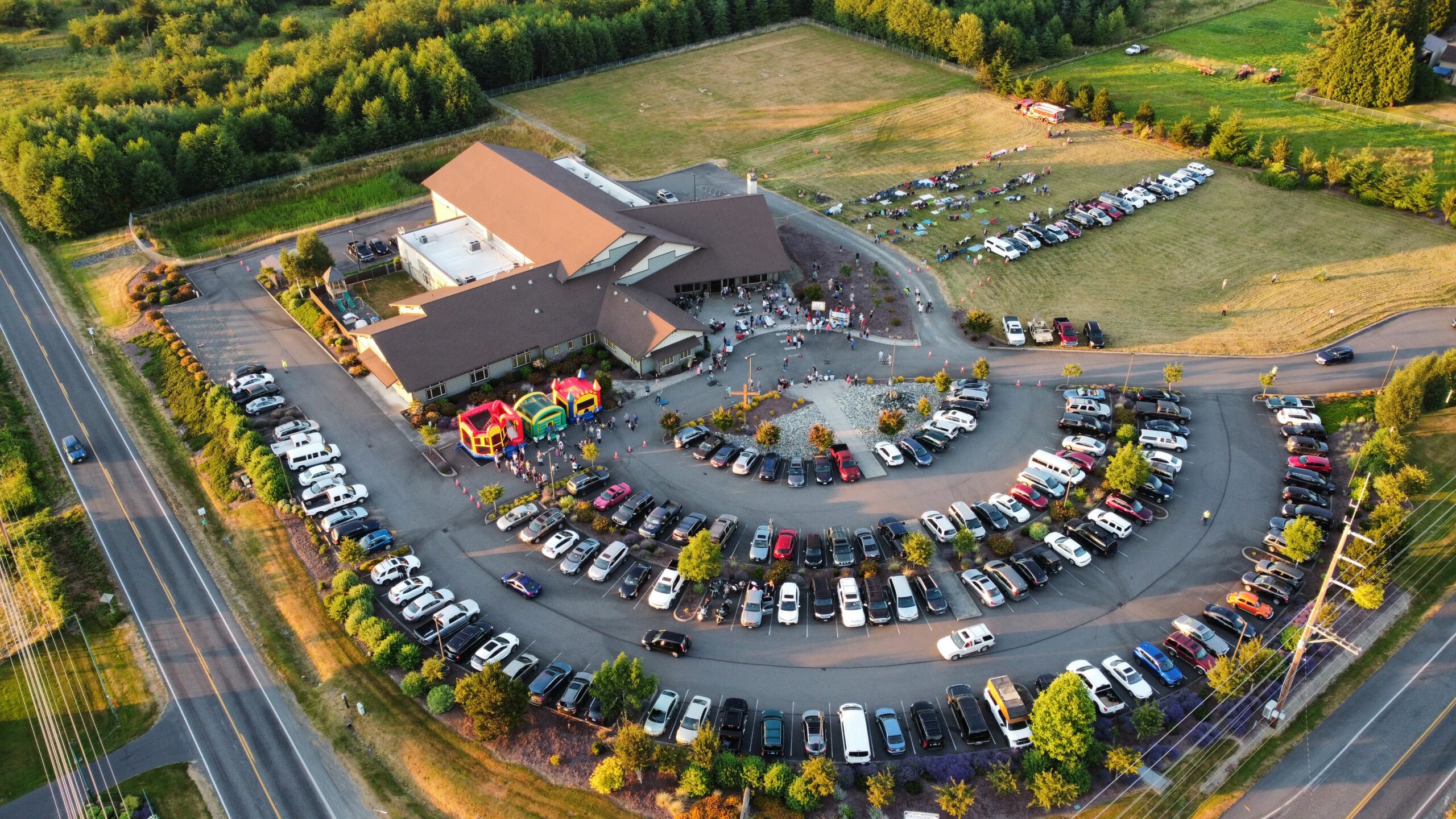
- WHAT WE DO
- Church Multiplication
- Church planting continues to be a crucial area of ministry for USMB. Studies show churches are the most effective way to bring more people into the family of God. Partnering with local churches, districts, USMB and Multiply to plant churches, is not just a good thing to do, we must do it.Read More
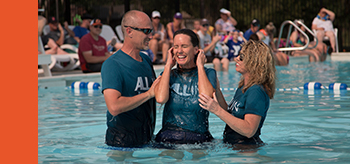
- Disciple-Making
- USMB is actively involved in helping provide our churches with dynamic ideas, resources and programs for encouraging people to become fully-devoted followers of Jesus. Jesus said, “Go and make disciples….” We strive to facilitate that profound command. READ MORE about Disciple-making.Read More
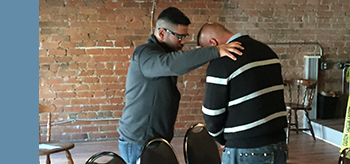
- Leadership Development
- USMB’s leadership development strategy stems from the real need to actively develop more leaders within the local church who are living on mission in the workplace and in their communities and to fulfill the demand for additional pastors, church planters and missionaries. READ MORE about Leadership Development opportunities.Read More

- Leadership Development
- RESOURCES
- EVENTS
- CONTACT
- CHURCHES
- JOBS
- Disciple-Making
-
- Church Multiplication

Increasing Impact Together
T 800-257-0515
Email: offices@usmb.org
USMB
PO Box 20200 Wichita, KS 67208
PHONE: 800-257-0515 NEWSLETTER: SIGN UP
BYLAWS OF
THE UNITED STATES CONFERENCE
OF THE
MENNONITE BRETHREN CHURCHES
(Approved July 28, 2012)
(Amended July 26, 2014)
ARTICLE I. GENERAL
Section 1. Name. The name of this corporation shall be The United States Conference of the Mennonite Brethren Churches (hereinafter referred to as “the U.S. Conference” or “the Conference”).
Section 2. Confession of Faith. The “Confession of Faith of the United States and Canadian Conferences of the Mennonite Brethren Churches,” as amended from time to time (“the Confession of Faith”), shall be the confession of faith of the Conference. Any doctrinal statement issued by or on behalf of the Conference shall be in harmony with the Confession of Faith.
Section 3. Policies and Procedures. The Conference may, from time to time, establish policies and procedures setting forth, in more detail, guidelines concerning the Conference’s structures and operations. Conference boards, committees or commissions may also be authorized by the Conference to establish such policies and procedures. Any such policies and procedures shall be subject to and in harmony with the Confession of Faith, these Bylaws and the Articles of Incorporation of the Conference.
Section 4. Fiscal Year. The fiscal year of the Conference shall begin on January 1 in each year. A regular convention of the Conference (Article V, Section 1) shall constitute the annual meeting of the Conference to the extent one is required by law. In years in which no regular convention is held, the first meeting of the Leadership Board in the fiscal year shall constitute the annual meeting of the Conference. In the latter instance, the Leadership Board shall serve as the representatives of the members of the Corporation for the purpose of conducting the annual meeting.
Section 5. Constituent District Conferences. District conferences are geographically-structured regional sub-units which are comprised of churches which are also members of the U.S. Conference. At the present time, these districts include the Central District, Latin American District (LAMB), North Carolina District, Pacific District and Southern District. District conferences are subordinate to the U.S. Conference as set forth in Article IV, Section 2 of these Bylaws, but are self-governing and operate under their own governing documents and structure. New district conferences may be created by the U.S. Conference as deemed necessary from time to time and, if deemed necessary, the U.S. Conference may work in conjunction with an existing district conference to realign its geographic borders.
ARTICLE II. PURPOSE
Section 1. General. In order to work more effectively and successfully, the Mennonite Brethren churches of the United States (“member churches”) have joined together to become a corporate body in the form of the U.S. Conference. The Conference shall build and maintain a strong Mennonite Brethren identity in the Anabaptist/Evangelical tradition, by affirming, clarifying and proclaiming the Good News of Jesus Christ as given to us in the Scriptures. The Conference shall intentionally pursue obedience to the Kingdom assignment of Jesus to make disciples of all Nations, by inviting people into a faith-follow relationship with Him, and baptizing and teaching obedience in all things, the Lord of the church.
Section 2. Ministries. In order to carry out its purpose, the Conference shall initiate and coordinate ministries within its purview, encourage and facilitate an assertive program of evangelism and church planting, encourage faithful discipleship in all matters of faith and life as defined by the Confession of Faith, and encourage and develop leadership at all levels of the conference: the local churches, the district conferences, and the United States Conference. The initiation of new ministries in cross-cultural evangelism and church planting shall be in consultation and cooperation with the district conferences.
ARTICLE III. MEMBERSHIP
Section 1. Members. The membership of the Conference shall consist of such churches that are founded on Christ and the Word of God, subscribe to the Confession of Faith of the U.S. Conference, and have been admitted as members by the Conference.
Section 2. District Conference Members. All churches who are members of the constituent district conferences shall automatically be members of the U.S. Conference. When a district conference accepts a new member church, it shall promptly advise the U.S. Conference of its action.
Section 3. Non-District Conference Members. A church that desires to become a member of the Conference but is not within the geographic borders of any district conference may make application for membership directly to the Conference. The Conference shall establish procedures for the consideration of such an application and the acceptance of such churches.
Section 4. Termination of Membership. A member church whose membership in a district conference is terminated, either by its withdrawal or by action of the district, shall also cease to be a member of the U.S. Conference. The district conference will promptly notify the Conference of any such termination. The U.S. Conference may also establish procedures whereby the Conference may initiate action to terminate a church’s membership in the Conference. A church whose membership in the U.S. Conference is withdrawn or terminated cannot remain a member of a district conference and its membership in any district conference shall be automatically terminated as well.
Section 5. Fraternal Relations. The Conference may establish fraternal relations with non-member church congregations having similar statements of faith and practices in order to provide opportunity for worship, fellowship and ministry of mutual interest. The Conference may establish policies and procedures regarding the formulation and implementation of fraternal relations agreements for this purpose.
ARTICLE IV. CONFERENCE RELATIONSHIPS
Section 1. Relation to the Members Churches.
A. Except as otherwise limited in these Bylaws or in the bylaws of the district conferences, each member church is a self-governing body with regard to its own local affairs. It fills all offices within the church and performs the services to which it has been called of God through Jesus Christ. Member churches agree and commit, in all matters, to subscribe to the Confession of Faith.
B. Member churches are accountable to each other as interdependent partners. Churches may invite counsel and assistance from the Conference. The Conference, through the Leadership Board and/or appropriate boards, committees or commissions, may intervene when problems arise within a member church. In all such instances the Conference shall strive to work in cooperation with the appropriate district conference.
C. Member churches shall accept as binding the decisions of the U.S. Conference and commit themselves to support the actions and projects of the Conference, both spiritually and materially, and to carry them out in the best possible manner. They agree that the Conference shall have the right to make the final decision in all matters that relate to the Confession of Faith, these Bylaws, the united activities, and the common welfare of the churches.
D. Should a member church withdraw from the Conference, or be dissolved, its capital assets shall become the property of the district conference of which the church is a member. If the church is not a member of any district conference, its assets shall become the property of the U.S. Conference.
Section 2. Relation to District Conferences.
A. The U.S. Conference shall strive to work with the district conferences in carrying out the mission of the Mennonite Brethren in the United States.
B. As the member churches of the U.S. Conference are also members of the several district conferences, they agree that the governing documents of the district conferences shall be consistent with those of the U.S. Conference, and that in case of a conflict of principle, theology, or jurisdiction between the district conferences and the U. S. Conference, the latter shall take precedence.
C. The district conferences commit to cooperate and participate positively in the administration and execution of the organization and ministries of the U. S. Conference, and pledge to support all the activities of the Conference.
D. Should a district conference be dissolved, after payment of all debts and liabilities, its remaining assets shall be distributed to the U.S. Conference.
Section 3. Relation to Mennonite Brethren Agencies, Institutions and Ministries.
A. Representative Relationships. The Conference provides representatives to the governing boards of certain organizations. Examples include Mennonite Brethren Foundation and MB Mission. These organizations are accountable to the Conference through these representatives and the Conference elects or appoints these representatives in accordance with the bylaws of the respective organization and these Bylaws (particularly Article VII, Section 6). Additionally, the Conference has a communication link with these organizations through the Leadership Board. The Leadership Board may delegate responsibility for communication with such organizations to the National Director or an appropriate board, committee or commission.
B. Other Relationships. The Conference maintains a communication link with other Mennonite Brethren organizations. Examples include Fresno Pacific University and its Seminary, Tabor College, the Canadian Conference of Mennonite Brethren Churches and the International Community of Mennonite Brethren (ICOMB). The Leadership Board maintains these communication links directly or by delegation to the National Director or an appropriate board, committee or commission.
Section 4. Relation to Inter-Mennonite and Inter-Faith Agencies. The Leadership Board, directly or by delegation to the National Director or an appropriate board, committee or commission, shall represent the Conference with regard to Inter-Mennonite and Inter-Faith agency relationships. The Conference has no authority over such agencies but may desire to have a communication link with them. Examples include Everence, Mennonite Central Committee, Mennonite Disaster Service, Mennonite Health Services, and the National Association of Evangelicals.
ARTICLE V. CONVENTIONS
Section 1. Regular Convention. The Conference shall meet biennially in a regular convention for purposes such as worship, fellowship, instruction and to transact the business of the Conference. The location of regular conventions and the program to be followed shall be determined by the Leadership Board.
Section 2. Special Conventions. When deemed necessary, special conventions may be called by the Leadership Board. Before convening a special convention, the Leadership Board shall furnish all member churches with a detailed report giving cause for calling such a convention. Except in the event of an emergency, notice as to the place and date of the special convention shall be provided to member churches not less than ninety (90) days prior to the proposed convention date.
Section 3. Representation. Churches are expected to participate in conventions by sending delegates. Each member church of the Conference shall be entitled to representation by one delegate for every fifty (50) individual members or fraction thereof plus a pastor. If a church does not have a pastor at the time of the convention, a designated leader of the church may attend in that role. The pastor, or another designee of the church, shall be prepared to provide the Secretary of the Conference with a list of the delegates attending as representatives of their church. Members of Conference boards and committees shall be considered delegates by virtue of their office. No person may serve as a delegate who is not a member in good standing of a member church. If a delegate’s qualifications are questioned, the matter shall be referred to the Leadership Board for resolution.
Section 4. Quorum. A quorum for any session of a convention shall consist of one-half of the number delegates who have been registered as attending.
Section 5. Convention Procedure. All discussions should be characterized by a Christ-like spirit. To proceed in an orderly fashion, generally accepted rules of order shall be followed. Decisions shall be determined by a majority of all votes cast unless otherwise required by these Bylaws. Voting shall be by the individual delegates present and may not be cast by proxy. A delegate may not speak on any point more than three times without special permission granted by the Chair. A delegate is to address the Chair and not interrupt another speaker nor become personal or offensive. The Chair shall have authority to rule a delegate out of order.
Section 6. Interim Action. During the interim period between regular conventions, the Leadership Board shall serve as the convention in the interim and shall be empowered to take such action as is necessary to conduct the affairs of the Conference. In the event the Leadership Board determines that a matter is of such significance that it should be acted on by the entire Conference, the Leadership Board shall submit the matter to each of the member churches for their consideration and shall establish a deadline by which the churches shall respond. The matter shall be determined by a majority vote of the member churches responding by the prescribed time unless a greater majority is required by these Bylaws.
ARTICLE VI. ORGANIZATION
Section 1. Executive Officers. The officers of the Conference shall be elected at a convention in accordance with Article V. of these Bylaws. The officers shall consist of the Chair, Vice-Chair, Secretary and Treasurer.
A. The Chair. The Chair shall preside at all convention sessions and at all meetings of the Leadership Board and shall perform the usual functions of a presiding officer according to accepted parliamentary procedure and organizational structure.
B. The Vice-Chair. The Vice-Chair shall serve in the capacity of the Chair in the Chair’s absence, or during the Chair’s inability to serve for any reason, or as requested by the Chair.
C. The Secretary. The Secretary shall ensure a permanent record of all proceedings of conventions and meetings of the Leadership Board. The Secretary shall prepare minutes of conventions for publication and shall collect the minutes of all boards, committees and commissions of the Conference and place them in a permanent file. The Leadership Board may, from time to time, appoint assistant secretaries to record minutes or otherwise assist the Secretary. The Secretary shall perform all such other duties as are incident to this office.
D. The Treasurer. The Treasurer serves as the chief financial officer of the Conference and also serves as a voting member of the Mennonite Brethren Foundation Board of Directors pursuant to the bylaws of that organization. The Treasurer, individually or through a designee, shall cause regular reports on the current financial status of the Conference to be made to the Leadership Board and the Conference, and shall perform all the other duties incident to this office.
E. Term of Office. Officers are elected for two-year terms and may succeed themselves twice in their respective offices.
Section 2. Leadership Board
A. Membership. The Leadership Board shall be comprised of
i. The Executive Officers (Chair, Vice-Chair, Secretary and Treasurer) elected by the Conference at its convention;
ii. Five Members-at-Large elected by the Conference at its convention; and
iii.Up to two Members-at-Large appointed by the Leadership Board.
The Leadership Board should reflect appropriate balance among the district conferences and must have at least four members who live geographically west of the Rocky Mountains and four members who live east of the Rocky Mountains.
B. Term of Office and Limitations. Members-at-Large of the Leadership Board shall be elected for four-year terms which, to the extent possible, shall be staggered so as to allow for continuity. An individual may not serve more than eight consecutive years on the Leadership Board either as an Officer, Member-at-Large, or combination thereof. However, a partial term served as a result of a vacancy shall not be counted in calculating the eight-year limitation.
C. Duties and Authority. The Leadership Board is directly accountable to the Conference and shall perform its duties independent of supervision by other boards, committees, commissioners or organizations. Consistent with the Articles of Incorporation, Bylaws and Confession of Faith, the Leadership Board shall have the responsibility and authority to do the following:
i. Manage the financial and legal affairs of the Conference including the conveyance and acceptance of property and other assets, overseeing the prudent management and investment of the Conference’s material assets, and executing such legal documents as may be necessary on behalf of the Conference;
ii. Carry out the purposes of the Conference as directed by the Conference in convention session;
iii. Serve as the convention in the interim.
iv. Design its own governance structure;
v. Select and employ, on such terms and for such length of time as it may determine, a National Director who shall carry out the administration of Conference affairs within limits of authority established by the Leadership Board and perform such other duties as are set forth in these Bylaws or determined by the Leadership Board;
vi. In its discretion, employ other ministerial and/or administrative staff and hire agents and professional personnel, on such terms and for such length of time as it may determine, to assist the Leadership Board in carrying out the work of the Conference, and to establish the limits of authority of such individuals;
vii. Appoint commissions to perform designated tasks
viii. Foster communication and coordinate the ministries of the various boards, committees and commissions of the Conference;
ix. Maintain Conference relationships as set forth in Article IV of these Bylaws;
x. Give vision and direction to the Conference and lead in strategic planning.
D. Meetings. Meetings of the Leadership Board may be called as necessary by the Chair. All meetings shall be open to the Conference membership, except that the Leadership Board, at the discretion of the Chair, may meet in closed session without prior notice. At the discretion of the Chair, the Leadership Board may meet and may take votes by electronic means.
Section 3. Board of Faith and Life.
A. Membership. The Board of Faith and Life shall be comprised of
i. Four members elected by the Conference at its convention, two of whom live west of the Rocky Mountains and two of whom live east of the Rocky Mountains;
ii. The District Ministers from each of the district conferences, who shall all serve as ex officio members with full voice and vote; and
iii. The Conference’s National Director who shall serve as an ex officio member with full voice but no vote.
The Board of Faith and Life shall select a chair from among its membership and otherwise organize itself to allow for the efficient undertaking of its duties.
B. Term of Office. The ex officio members of the Board of Faith and Life shall not be subject to term limits, while the elected members shall be elected for four-year terms and may succeed themselves once.
C. Duties and Authority. The Board of Faith and Life is directly accountable to the Conference and shall perform its duties independent of supervision by other boards, committees, commissioners or organizations. Consistent with the Articles of Incorporation, Bylaws and Confession of Faith, the Board of Faith and Life shall have the responsibility and authority to do the following:
i. Provide spiritual oversight and serve as the guardian of the Confession of Faith;
ii. Process, in consultation with the Leadership Board, any proposed amendments, changes or modifications to the Confession of Faith and establish procedures for the presentation of such proposals to the Conference for approval at a regular or special convention, provided however, that such procedures must require an affirmative vote of at least two-thirds (2/3) of the delegates present and voting at the convention in order for an amendment, change or modification to the Confession of Faith to be effective.
iii. Watch over the spiritual life of the Conference and its member churches and serve as a reference to give guidance and direction in matters of faith, doctrine and ethics;
iv. Function as an advisory board to district conferences in matters of ethics, doctrine, and polity;
v. Initiate appropriate disciplinary action when conditions contrary to the teaching of the Bible and the principles of the Conference exist in our churches and conferences;
vi. Convene study conferences for purposes of consultation and discernment on issues of faith, discipleship or polity; and
vii. Commission the dissemination of information in print and other media to facilitate wider participation in study and consensus building.
D. Meetings. Meetings of the Board of Faith and Life may be called as necessary by the Chair. At the discretion of the Chair, the Board of Faith and Life may meet and may take votes by electronic means.
ARTICLE VII. ELECTIONS
Section 1. Nominating Committee.
A. Membership. The Nominating Committee shall be a standing Conference committee and shall consist of the National Director and one representative from each district conference. The district conferences shall be represented on the Committee by their District Minister or his appointee. If a district conference has no district minister, the leadership body of the district conference may appoint a representative to serve on the Committee. The Committee shall select a chair from among its membership and otherwise organize itself to allow for the efficient undertaking of its duties.
B. Duties. The Nominating Committee will be convened as necessary by the National Director of the U.S. Conference and shall submit nominations to the Leadership Board for approval. The Nominating Committee shall present a ballot of nominees for all elected positions within the Conference. The Committee may seek suggestions from member churches and other Conference boards, committees and commissions.
C. Additional Nominations. Delegates to a convention may submit the names of additional candidates to the Nominating Committee which shall then determine the candidate’s eligibility as set forth in Section 2 of this Article. Nominations from the floor which have not been submitted to the Nominating Committee in advance shall not be allowed.
Section 2. Eligibility. Nominees for any position within the Conference must be members in good standing of a member church for at least one year. Prior to nominating an individual, the Nominating Committee shall obtain the consent of the nominee and shall also consult with and receive affirmation from the nominee’s pastor or, in the absence of a pastor, their church leader.
Section 3. Commencement of Term. Terms of all elected Conference positions shall conclude, and the new terms commence, immediately after adjournment of the regular biennial convention.
Section 4. Removal. For just cause, the Leadership Board may remove any person occupying an elected or appointed Conference position and discharge or request the resignation of persons employed by the Conference or by any board, commission or committee of the Conference.
Section 5. Vacancies. If a person occupying an appointed or elected Conference position moves out of the Conference or a vacancy is created by reason of resignation, death, removal or otherwise, the vacancy shall be reviewed by the Leadership Board which may make the necessary appointment to fill the position in consultation with the applicable board, committee or commission. Such appointment shall be for the completion of the term and a partial term shall not count as a term for purposes of term limitations.
Section 6. Positions Outside the Conference. In the event the Conference is requested or required to elect or appoint representatives to organizations or agencies related to but outside the Conference structure, the Conference may establish procedures for the election or appointment of such representatives, notwithstanding the foregoing provisions of this Article. In the event any such organization or agency is allowed to submit nominees to the Conference for consideration, any such nominees shall be submitted to the Leadership Board for review. If the position is one over which the Leadership Board has the power of appointment, the Leadership Board may appoint the nominee or request that the organization or agency submit a substitute nominee. If the position is one that is to be elected by the Conference at convention, the Leadership Board may accept the nominee and advance the nomination to the convention, or reject the nominee and request that the organization or agency submit a substitute nominee.
This procedure shall not apply to those organizations whose corporate membership consists, in whole or in part, of the members of the Conference and whose bylaws provide for direct election of the organization’s board members by the Conference from nominees submitted by the organization.
ARTICLE VIII. AMENDMENT OF THE ARTICLES AND BYLAWS
Section 1. Procedure. The Bylaws and Articles of Incorporation of the Conference may be revised or amended by a two-thirds (2/3) vote of the delegates present and voting at a regular or special convention. The Leadership Board shall give notice of a proposed revision or amendment to member churches at least ninety (90) days prior to the convention at which the matter will be presented for action. This notice provision may be waived by a two-thirds (2/3) vote of the delegates at a convention.
Section 2. Content. No amendments to the Bylaws or Articles of Incorporation of the Conference may in any way be in conflict with any part of the Confession of Faith.
ARTICLE IX. SUSPENSION OR WAIVER OF BYLAWS PROVISIONS
Any provision of these Bylaws may be suspended or waived by a two-thirds (2/3) vote of the delegates present and voting at a regular or special convention, except that the provision regarding amendment of the Confession of Faith set forth in Article VI, Section C.3.ii. may not be so suspended.
ARTICLE X. DISSOLUTION
Section 1. Procedure. The Conference may be dissolved only upon the affirmative vote of two-thirds (2/3) of the delegates present and voting at a special convention called for that purpose pursuant to Article V, Section 2. of these Bylaws.
Section 2. Distribution of Assets. Upon dissolution, after payment of the Conference’s obligations, the remaining assets of the Conference shall be distributed in accordance with applicable law and in a manner recommended by the Leadership Board and approved by a two-thirds (2/3) vote of the delegates present and voting at the special convention discussed in Section 1 of this Article.

